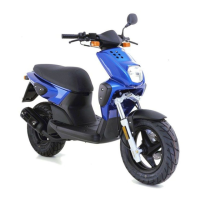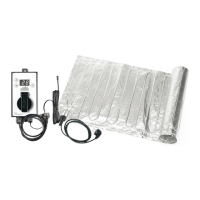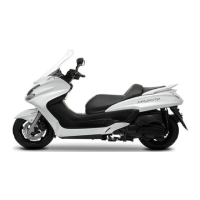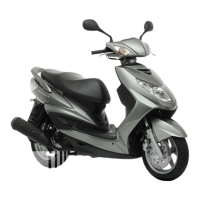Do you have a question about the Yamaha Exciter T150 and is the answer not in the manual?
Owner's role in safe operation, pre-ride checks, and riding techniques.
Importance of helmets, apparel, and making oneself visible to other motorists.
Risks of carbon monoxide, safe loading practices, and weight limits.
Advice on genuine vs. aftermarket parts, and tire considerations.
Safe riding practices for various conditions and transporting the vehicle.
Criteria for selecting and properly wearing motorcycle helmets.
Identification of key parts from left and right views of the motorcycle.
Locates and identifies the motorcycle's controls and instrument panel features.
Explains the functions and positions of the main switch and steering lock.
Explains the various indicator lights and warning signals on the instrument panel.
Details speedometer, tachometer, fuel gauge, and other display functions.
Explains transmission gear indication and fuel economy readings.
Identifies handlebar switches and operation of clutch/brake levers.
Operation of brake pedal, fuel cap, and fuel system information.
Information on catalytic converter, kickstarter, and seat operation.
Location of helmet holders, storage compartment, and sidestand function.
Step-by-step guide to starting the engine and proper gear shifting techniques.
Tips for reducing fuel consumption and crucial engine break-in procedures.
Safe parking instructions and general notes on motorcycle usage.
Overview of maintenance intervals and the owner's tool kit.
Procedures for checking engine oil level and replacing the oil filter element.
Checking coolant, cleaning air filter, and adjusting engine idle speed.
Inspection and maintenance of tires, wheels, and brake systems.
Lubrication of drive chain, control cables, and lever pivots.
Battery care, fuse replacement, and maintenance of lights.
Diagnosing starting problems, poor performance, and engine overheating.
Guidelines for cleaning the motorcycle, including specific precautions.
Proper methods for short-term and long-term storage to prevent damage.
Specifications for engine, fuel capacity, and transmission type/ratios.
Details on chassis, tire sizes, wheel types, and brake system components.
Specifications for electrical system, battery, lights, and fuses.
Location and importance of vehicle and engine serial numbers for identification.
Owner's role in safe operation, pre-ride checks, and riding techniques.
Importance of helmets, apparel, and making oneself visible to other motorists.
Risks of carbon monoxide, safe loading practices, and weight limits.
Advice on genuine vs. aftermarket parts, and tire considerations.
Safe riding practices for various conditions and transporting the vehicle.
Criteria for selecting and properly wearing motorcycle helmets.
Identification of key parts from left and right views of the motorcycle.
Locates and identifies the motorcycle's controls and instrument panel features.
Explains the functions and positions of the main switch and steering lock.
Explains the various indicator lights and warning signals on the instrument panel.
Details speedometer, tachometer, fuel gauge, and other display functions.
Explains transmission gear indication and fuel economy readings.
Identifies handlebar switches and operation of clutch/brake levers.
Operation of brake pedal, fuel cap, and fuel system information.
Information on catalytic converter, kickstarter, and seat operation.
Location of helmet holders, storage compartment, and sidestand function.
Step-by-step guide to starting the engine and proper gear shifting techniques.
Tips for reducing fuel consumption and crucial engine break-in procedures.
Safe parking instructions and general notes on motorcycle usage.
Overview of maintenance intervals and the owner's tool kit.
Procedures for checking engine oil level and replacing the oil filter element.
Checking coolant, cleaning air filter, and adjusting engine idle speed.
Inspection and maintenance of tires, wheels, and brake systems.
Lubrication of drive chain, control cables, and lever pivots.
Battery care, fuse replacement, and maintenance of lights.
Diagnosing starting problems, poor performance, and engine overheating.
Guidelines for cleaning the motorcycle, including specific precautions.
Proper methods for short-term and long-term storage to prevent damage.
Specifications for engine, fuel capacity, and transmission type/ratios.
Details on chassis, tire sizes, wheel types, and brake system components.
Specifications for electrical system, battery, lights, and fuses.
Location and importance of vehicle and engine serial numbers for identification.
| Engine Type | Liquid-cooled, 4-stroke, SOHC, 4-valve |
|---|---|
| Displacement | 149.7 cc |
| Fuel System | Fuel injection |
| Seat Height | 795 mm |
| Fuel Tank Capacity | 4.2 liters |
| Tires (Front) | 90/80-14 |
| Compression Ratio | 10.4:1 |
| Lubrication System | Wet sump |
| Clutch Type | Automatic centrifugal |
| Frame Type | Underbone |
| Front Suspension | Telescopic fork |
| Rear Suspension | Swingarm |
| Max Torque | 13.8 Nm |
| Transmission | Automatic |
| Brakes (Front) | Hydraulic Single Disc Brake |
| Brakes (Rear) | Drum |
| Ignition System | TCI |
| Starting System | Electric |
| Final Drive | V-belt |
| Bore x Stroke | 57.0 mm x 58.7 mm |











